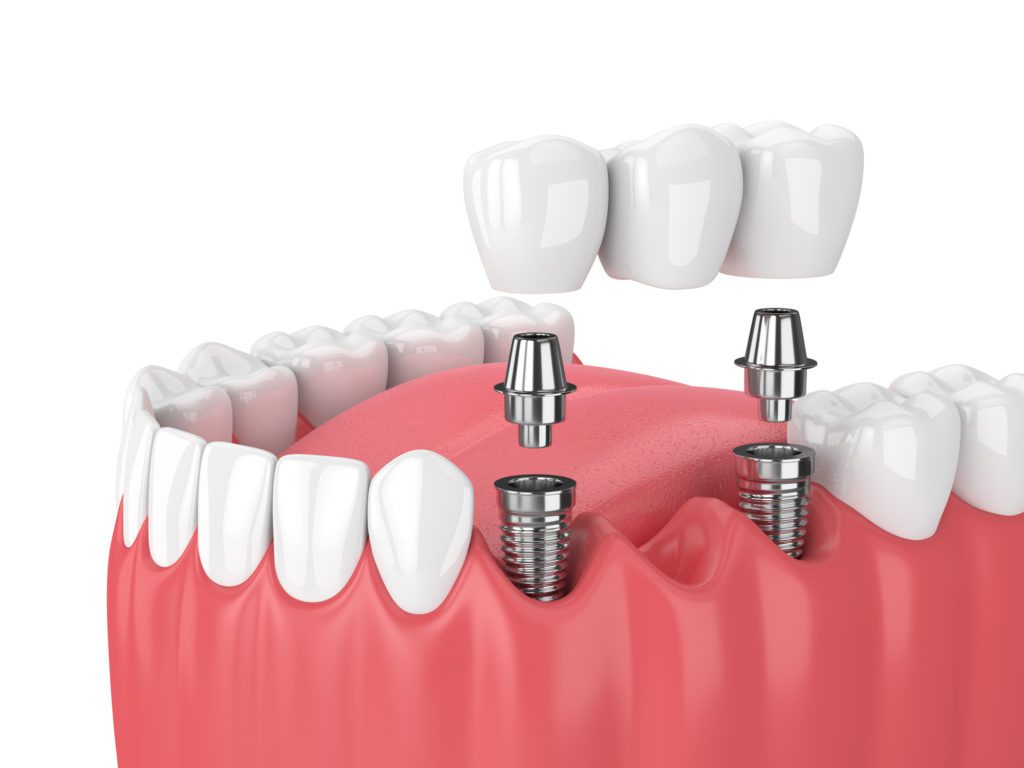Are you missing one or multiple consecutive teeth? Receive a dental bridge in our Newtown, PA dental office. Dental bridges are a restorative dentistry treatment that can replace a row of missing teeth or a single lost tooth. They use natural-looking dental crowns and durable metal materials for restorations that last.
Whether you have recently lost a tooth, or simply would like a replacement for an older restoration, our office can help.

Traditional vs. Implant-Secured Dental Bridges
Traditionally, dental bridges restore a single tooth or a row of consecutive missing teeth with crown-capped natural teeth. The teeth adjacent to the tooth cap are covered by dental crowns, which hold the dental prosthetic in place. However, there is a more secure way for patients to restore one or more teeth.
Dental bridges secured by dental implants offer longer-lasting treatment than more traditional options. This is because dental implants are surgically inserted into the jawbone. With implants, there is less risk of bone or gum deterioration. Implants support the health of the teeth and gums for many years.
Dental Bridge Treatment
Before we begin dental bridge treatment or any restorative treatment, we ensure that patients are in good physical and oral health. Patients who receive implant-secured dental bridges will require enough bone tissue to support the implant. We can recommend bone grafting to ensure that their implants successfully fuse with the bone tissue.
To begin, we take dental impressions of the teeth and gums. These impressions are used to create dental crowns and bridge prosthetics. Patients who receive implant-supported dental bridges will undergo oral surgery. We will insert several implants into the jawbone.
After a 3 to 6-month healing period, we will secure the bridge to the implants. For patients who want traditional bridges, they will receive their crowns after they are fabricated from their impressions.
Frequently Asked Questions
How long does it take to get a dental bridge?
The process of getting a traditional dental bridge typically involves at least two appointments and can take a few weeks. The first visit usually involves preparing the supporting teeth and making a mold or impression. The dentist or prosthodontist will send the impression to a dental lab to create the custom bridge.
The dentist will provide a temporary bridge or temporary crowns in between appointments. The second visit, often a few weeks later, involves placing and adjusting the final bridge.
Do dental bridges fall out easily?
No, dental bridges should not fall out easily. Collaborating with dental laboratory technicians, the prosthodontist or dentist will design dental bridges as a long-lasting solution for missing teeth. The prosthodontist or dentist securely attaches them to the surrounding teeth or implants.
However, they can become loose or fall out due to poor dental hygiene, trauma, or wear and tear over time. If a bridge does become loose or falls out, it’s important to contact your dentist immediately for a solution.
Do dental bridges come out at night?
No. Dental bridges are prosthetic devices that dentists cement onto the existing teeth or implants. Unlike removable dentures, you cannot take them out. They function like natural teeth, and you should care for them in the same way, including brushing and flossing daily.
How many teeth do you need to hold a bridge?
A traditional dental bridge requires at least two healthy teeth, one on either side of the gap where the missing tooth or teeth once were. These healthy teeth serve as the anchor points for the bridge.
However, the exact number can vary based on the type of bridge and the specific dental situation of the patients. For instance, an implant-supported bridge doesn’t rely on existing teeth, and a dentist might use them when several teeth in a row are missing.
What happens if you get a cavity under a bridge?
If a cavity forms under a dental bridge, a dentist or prosthodontist must remove it to treat the tooth. After the dentist or prosthodontist fill the cavity, they may need to fit a new bridge. This is why maintaining good oral hygiene, even with a bridge, is essential, including brushing, flossing, and regular dental checkups.
How painful is a dental bridge?
The process of getting a dental bridge should not be painful. Your dentist will use a local anesthetic to numb the area during the preparation of the teeth and the placement of the bridge.
However, some patients may experience some discomfort or sensitivity in the days following the procedure. This sensitivity usually subsides within a few days. You should report any ongoing discomfort to your dentist or prosthodontist for further evaluation.
Try Dental Bridges Today
Do you want to restore your smile? Contact our dental office for an appointment at 267-692-2394. You may also schedule a dental consultation with our team on our website. Please let us know if you have further questions about your restorative options. We will be glad to help.
